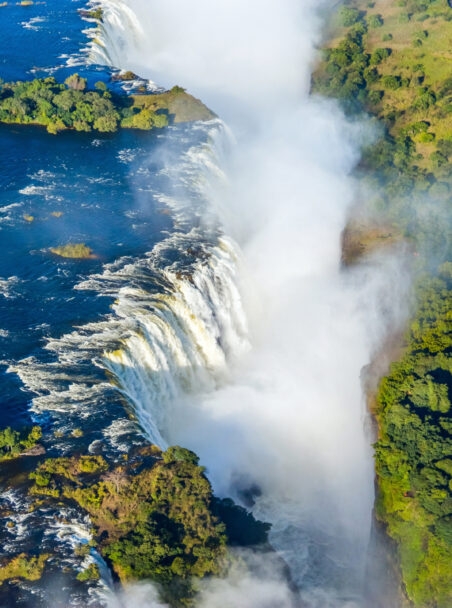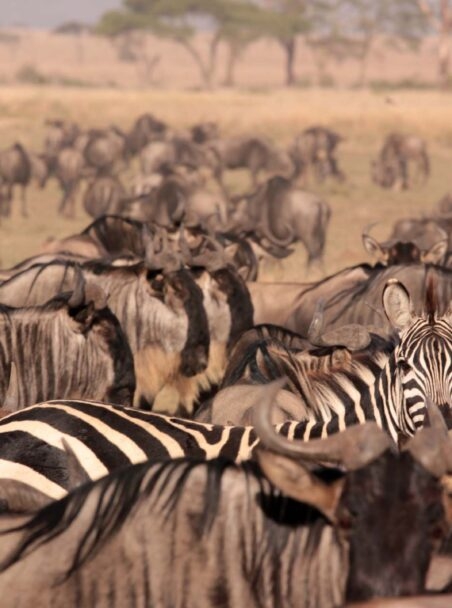Zimbabwe has a well-earned reputation as a leader in wildlife management, with several outstanding national parks, game reserves, safari areas and sanctuaries scattered across it. Located in southeast Africa between Botswana, Zambia, Mozambique and South Africa, it’s a bucket-list destination for animal lovers and adventurous travellers alike.
This country checks all the boxes for an exceptional African safari: vastly diverse landscapes, uncrowded expanses of wilderness, an endless array of animals (including the Big Five) and truly excellent guides. It’s also a trailblazer in responsible tourism, with multiple safari camps and lodges that belong to our Positive Impact Collection.
If you’re planning a trip to Zimbabwe, the best way to begin is by learning a bit about its national parks. These natural havens contain much of the country’s most impressive scenery, iconic wildlife and luxurious accommodation. With that in mind, we’ve asked our travel designers to select the top six national parks in Zimbabwe for an unforgettable trip.

Hwange National Park
The largest national park in Zimbabwe, Hwange National Park is the kind of place you simply can’t miss. Its landscapes range from lush teak forests to sparse sandveld, hosting more than 100 mammal species – many of them rare and/or endangered. Here you’re likely to spot elephants, wild dogs, lions, leopards, buffalo, cheetahs, rhinos, hyenas and much more.
Hwange is part of the enormous Kavango-Zambezi Transfrontier Conservation Area and hosts research initiatives like the National Leopard Project and the Painted Dog Project. The park often experiences intense droughts, leading animals to gather at scarce watering holes.
Need to know: Wilderness Little Makalolo and Wilderness Linkwasha, both of which are on our list of positive impact properties, collaborate with other camps to maintain man-made watering holes that help keep animals hydrated during droughts.

Victoria Falls National Park
Victoria Falls stands starkly apart from the other national parks in Zimbabwe, thanks primarily to the jaw-dropping natural wonder it’s named after. Boasting the title of the world’s largest waterfall, it straddles the border with Zambia – but it’s only from Zimbabwe’s Victoria Falls National Park that you can see the spectacular Devil’s Cataract.
In addition to visiting the falls, you can also enjoy the nearby town, relax in a riverside suite at Matetsi Victoria Falls or embark on an electrifying whitewater rafting trip. And for the real thrill seekers, bungee jumping off Victoria Falls Bridge is one of the best things to do in Zimbabwe.
Need to know: Although the best time to visit Zimbabwe’s national parks is generally during the dry season from April to October, Victoria Falls is a great place to go all year round.

Mana Pools National Park
If you want to explore Zimbabwe’s wilderness on foot, Mana Pools National Park is a wonderful place for expedition travel. Much of this park is inaccessible for vehicles, so walking safaris are highly recommended. You can also glide across the four lakes that lend it its name (mana means “four” in the local Shona language) in a canoe, keeping an eye out for hippos and Nile crocodiles.
Mana Pools is also home to elephants, lions, leopards, cheetahs, hyenas and many aquatic birds, all of which can be spotted on safari with an experienced tracker. It includes woodlands and the southern Zambezi Escarpment as well as the Zambezi River and the eponymous pools.
Need to know: If you’ve always wanted to see wild elephants up close, stay at Wilderness Ruckomechi; here it’s often possible to spot these majestic animals right from camp.

Matobo National Park
Matobo is the oldest national park in Zimbabwe – it received the official designation in 1926 – and offers a fascinating trifecta of wildlife, scenery and cultural heritage. Here you can admire massive rock formations and staggering kopjes, examine ancient cave paintings and learn about the traditions of the Indigenous Ndebele people.
Matobo National Park is renowned for its large populations of leopards, black eagles and both black and white rhinos, though there are plenty of other animals to see as well. For something a bit different, you can also visit the burial site of King Mzilikazi, founder of the Ndebele Kingdom.
Need to know: Stay at the rustic yet elegant Amalinda Lodge, carved directly into the rocky landscape, to really immerse yourself in the magic of Matobo Hills.

Gonarezhou National Park
Endless expanses of nature with few visitors and no buildings in sight – that’s what you’ll find in Gonarezhou National Park, which is both the second-largest and the least-visited of all the wildlife parks in Zimbabwe, making it an ideal choice for remote travel. You’re more likely to cross paths with some of the park’s thousands of elephants than with other travellers – not to mention giraffes, rare king cheetahs and more.
There are very few lodges in and around Gonarezhou – that’s a big part of its allure – but the cliffside Chilo Gorge Safari Lodge (set just past the park’s northeastern edge) is undoubtedly our favourite. It offers phenomenal views and the chance to stay overnight inside the park itself.
Need to know: Gonarezhou is located in the country’s southeastern corner and is part of the Great Limpopo Transfrontier Park: an immense protected area, or ‘peace park’, that promotes conservation and community support across Zimbabwe, South Africa and Mozambique.

Matusadona National Park
Located in northern Zimbabwe on the shores of Lake Kariba – the world’s largest man-made reservoir – Matusadona National Park is an ideal destination for travellers who enjoy off-the-beaten-path travel. Beyond the lake, the park also includes woodlands, part of the Zambezi valley and a dramatic escarpment.
Matusadona has a complex history, with challenges including poaching and resource depletion, but recent revitalisation efforts have been highly successful. Today it hosts thriving populations of big game, zebras, impalas and elephants, as well as abundant fish and birdlife.
Need to know: Fothergill offers a wholly unique experience – starting with its gorgeous setting on an island in Lake Kariba – and works hard to protect its surroundings. The camp runs on 95% solar energy and promotes sustainable fishing and water-based safaris.
Whatever you want from your adventure in Zimbabwe, our travel designers are ready to help:










